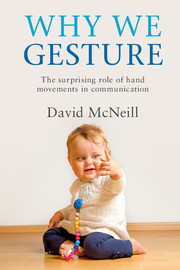7 - Ontogenesis
from Part II - Phylogenesis, ontogenesis, brain
Published online by Cambridge University Press: 05 December 2015
Summary
Picking up a thread from Chapter 6 that “Acquisition 1” recapitulates gesture-first and then its extinction, we take up “Acquisition 2” and its effects on current-day language ontogenesis. The earliest steps that infants take toward language are like those of a gesture-first creature. This language then extinguishes in children, as it did in the gesture-first creature, and is followed by a second acquisition in the same children. The second acquisition is for gesture–speech unity and is the language we actually evolved as a species. Gesture–speech unity emerges when the thought–language–hand link brain structures underlying it mature at age three or four, as neurological and psychological data suggest. Gestures now relate to speech in a new way—the single semiosis of speech–gesture combinations replaced by the dual semiosis of gesture-orchestrated speech.
Two to three acquisitions
A “two-acquisitions” portrayal is the topic of the current chapter. Importantly, the first acquisition leaves few traces in the second; extinction wipes them out, as though the two languages appear with no relationship. Only words carry forward but the Pivot-Open grammars vanish. There is also a “third acquisition” of speech adapted to attract adult attachment that actually begins before Acquisitions 1 and 2. It provides continuity through the ontogenesis and extinction of Acquisition 1 and then merges with Acquisition 2. These stages include not only the development of human language but also that of a long-gone human precursor, an archetype brought back to life for a time. For current-day children, the argument implies, contrary to a longstanding assumption that children develop more or less continuously (perhaps with stages, but earlier acquisitions still carrying forward), that ontogenesis is not cumulative; it is a mixture of continuity and discontinuity. Discontinuities come from the recapitulation of the two origins. Continuities come from the autonomous development of speech control. Autonomous development could be due to other evolutionary pressures, such as speech control to garner parental attachment (“baby-talk” being the adult half of the adaptation; it is automatic and unthinking, and the mere sight of an infant or a surrogate infant triggers it; all qualities that suggest a built-in response. I was once introduced to a Bunraku puppet.
- Type
- Chapter
- Information
- Why We GestureThe Surprising Role of Hand Movements in Communication, pp. 142 - 156Publisher: Cambridge University PressPrint publication year: 2015



